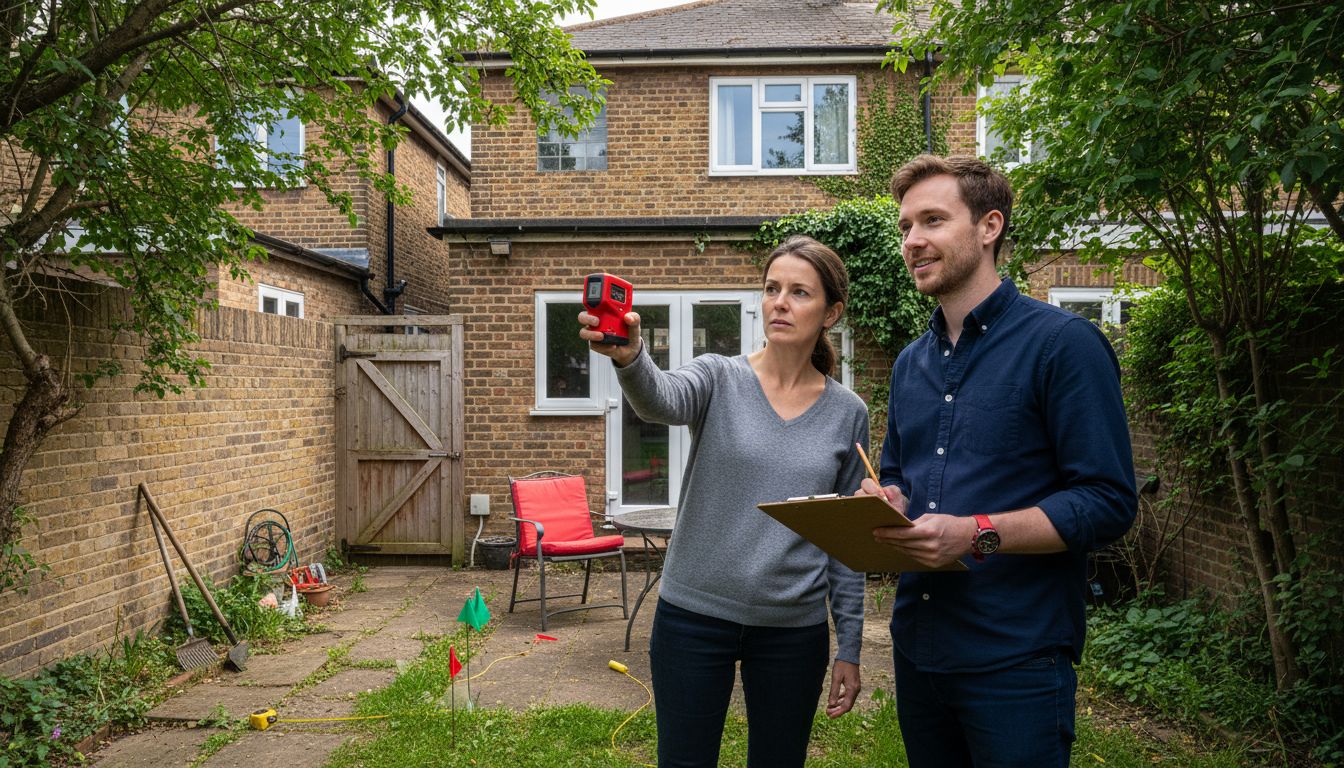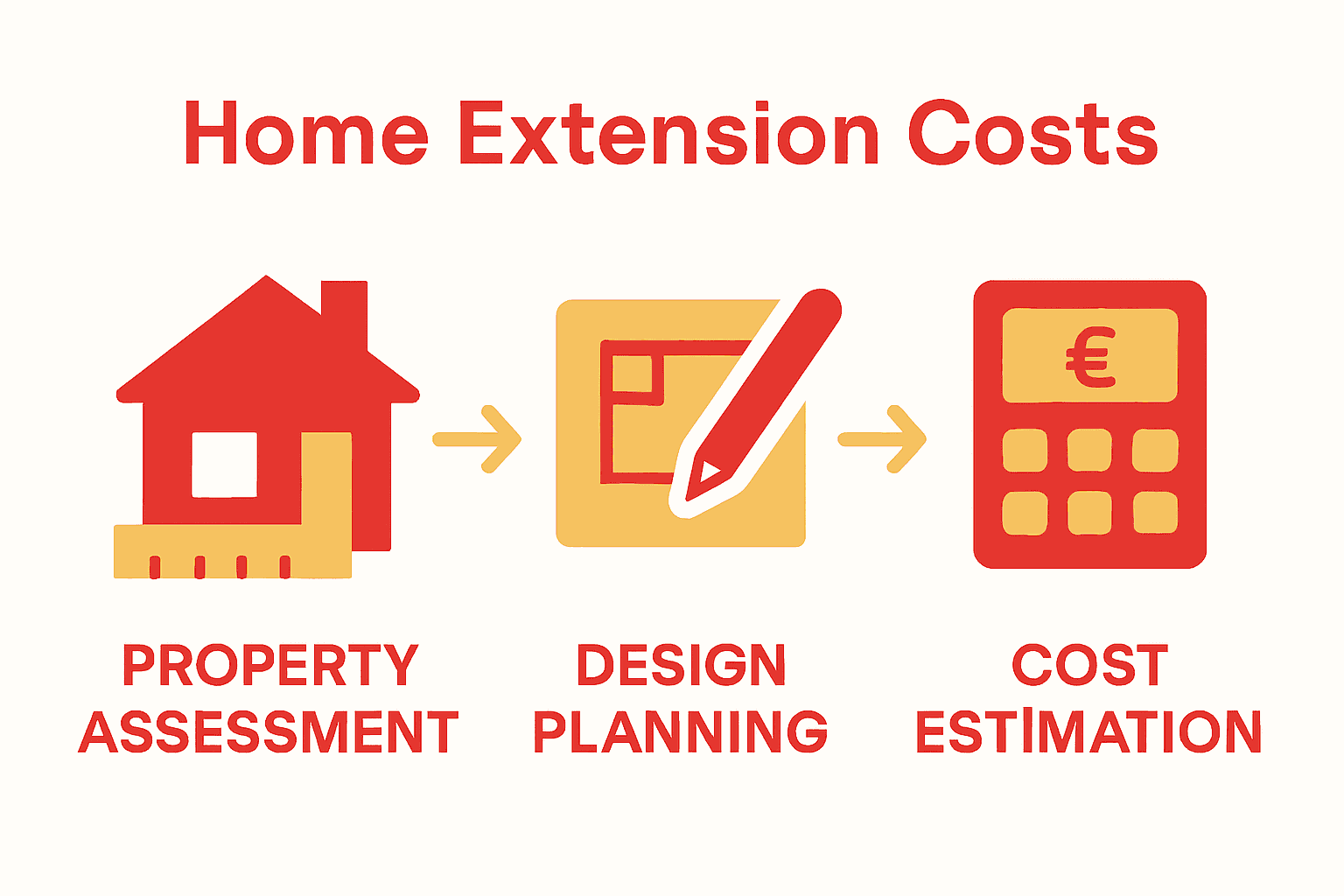Nearly half of homeowners underestimate the complexity of planning a home extension and face costly setbacks as a result. Expanding your living space promises greater comfort and value but getting it right starts long before any construction begins. From identifying your household’s true needs to navigating design and budget decisions, careful early steps pave the way for a smooth project. This guide delivers practical strategies for each stage so you can move forward with clarity and confidence.
Table of Contents
- Step 1: Assess Your Property And Extension Needs
- Step 2: Gather Essential Design And Planning Details
- Step 3: Calculate All Key Extension Costs
- Step 4: Review Legal And Permit Requirements
- Step 5: Validate Estimates And Set Your Budget
Quick Summary
| Key Point | Explanation |
|---|---|
| 1. Assess Property Before Planning | Evaluate your home’s layout and outdoor space to identify feasible extension areas. Consider functionality and flow to optimize design. |
| 2. Develop Detailed Design Plans | Create comprehensive architectural sketches showing how your extension integrates with the existing home. Ensure visual harmony with surrounding properties. |
| 3. Calculate All Extension Costs | Break down costs into categories like materials, labor, and permits. Include a contingency fund to cover unexpected expenses during construction. |
| 4. Understand Legal Requirements | Secure necessary planning permissions and building regulations before starting to avoid costly delays or legal issues. Consult professionals for guidance. |
| 5. Validate Estimates and Set Budget | Request multiple quotes from contractors to ensure accurate budgeting. Always include hidden costs and ensure financial clarity before proceeding. |
Step 1: Assess Your Property and Extension Needs
Setting the foundation for a successful home extension begins with a thorough assessment of your current property and understanding your specific space requirements. This critical first step will help you determine the potential and limitations of your extension project.
According to the HomeOwners Alliance, evaluating your property involves carefully examining several key factors. Start by measuring your available outdoor space and understanding your property’s current layout. Look at potential areas for expansion such as rear gardens, side passages, or unused outdoor areas. Consider how the extension will interact with existing rooms and the overall flow of your home.
Your assessment should focus on three primary aspects: functionality, structural feasibility, and aesthetic integration. Ask yourself what specific needs you want to address. Are you seeking additional living space? A new kitchen? A home office? Each purpose will influence the design and scope of your extension. Pay attention to potential challenges like building regulations, planning permissions, and structural constraints. A strategic approach means considering not just what you want now but how the space will serve your lifestyle in the coming years.

Warning: Be realistic about your property’s limitations. Not every home can accommodate the extension you initially envision, so flexibility and professional guidance are key. Consider consulting an architectural professional who can provide expert insights into your specific property’s potential.
Next, you will move into the detailed design phase where these initial assessments will inform your extension plans.
Step 2: Gather Essential Design and Planning Details
With your initial property assessment complete, the next crucial phase involves collecting comprehensive design and planning details that will transform your extension vision into a concrete blueprint. This stage requires careful consideration and detailed documentation to ensure your project meets both your personal needs and local regulatory requirements.
According to the Buckinghamshire Council, developing design plans demands meticulous attention to materials, scale, and proportions. Start by creating detailed sketches or working with an architectural professional to draft initial concept drawings. These plans should demonstrate how the proposed extension will integrate seamlessly with your existing property. Consider aspects like window placements, roofline continuity, and material matching to ensure architectural harmony.
The Wigan Council’s Design Guide emphasizes the importance of maintaining visual consistency with your surrounding area. This means carefully selecting materials that complement your existing structure and neighborhood aesthetic. Take photographs of your current property, measure existing room dimensions, and document key architectural features that will inform your extension design.
Warning: Precision is paramount. Even minor miscalculations in your initial design can lead to significant complications during the planning permission process or construction phase. Always double-check measurements and consider getting a professional survey to ensure absolute accuracy.
Next, you will begin researching specific planning permissions and building regulations that apply to your proposed extension.
Step 3: Calculate All Key Extension Costs
With your design plans ready, it is time to dive into the critical process of calculating your extension costs. This stage transforms your architectural vision into a financial roadmap, helping you understand the full economic scope of your home improvement project.

According to Livingetc, calculating extension costs involves carefully evaluating multiple factors beyond simple square meter pricing. You will need to break down expenses into several key categories including materials, labour, professional fees, and potential structural modifications. For London homeowners, expect costs to range between £1500 to £2500 per square meter depending on the complexity of your design and specific location within the city.
Ideal Home highlights that regional variations and specific extension types can significantly impact your budget. Kitchen extensions, for instance, typically require more specialized work and can be more expensive due to plumbing, electrical, and appliance installations.
Create a comprehensive spreadsheet tracking potential expenses including:
- Base construction costs
- Material expenses
- Labour fees
- Architectural and planning permissions
- Potential utility modifications
- Contingency funds (recommended 10 15% of total budget)
Warning: Always include a financial buffer. Unexpected challenges during construction can quickly escalate costs, so maintaining flexibility in your budget is crucial.
Next, you will begin obtaining detailed quotes from multiple contractors to validate your initial cost estimations.
Step 4: Review Legal and Permit Requirements
With your project costs calculated, the next critical phase involves navigating the complex landscape of legal permissions and regulatory compliance for your home extension. Understanding and securing the necessary approvals will prevent potential costly delays or legal complications.
According to the HomeOwners Alliance, reviewing legal requirements is not a simple checkbox exercise but a comprehensive process involving multiple authorities. Most home extensions in London will require two key approvals: planning permission and building regulations consent. Planning permission focuses on how your extension looks and impacts the surrounding area, while building regulations ensure the structural integrity and safety of your new space.
To streamline your legal review, follow these essential steps:
- Contact your local planning authority to confirm specific requirements
- Prepare detailed architectural drawings
- Assess whether your project falls under permitted development rights
- Determine if you need a party wall agreement with neighbours
- Submit comprehensive documentation for review
- Budget for potential application fees
Warning: Proceeding without proper permissions can result in enforcement actions requiring you to remove the extension or face significant financial penalties. Always consult professional guidance to ensure full compliance.
Next, you will begin preparing the comprehensive documentation required for your planning permission application.
Step 5: Validate Estimates and Set Your Budget
With legal requirements understood, you now enter a crucial phase of transforming your extension project from concept to financial reality. This step involves critically examining your initial cost estimates and establishing a robust financial framework that balances your vision with practical affordability.
Livingetc emphasizes the importance of comprehensive cost validation, highlighting that initial estimates often fail to account for recent changes in material prices and evolving building regulations. To validate your budget effectively, request detailed quotes from at least three reputable contractors, comparing their breakdowns line by line. Pay close attention to potential hidden costs such as waste removal, temporary accommodation during construction, and any necessary structural reinforcements that might not be immediately apparent in initial projections.
Ideal Home recommends considering your extension as an investment, not just an expense. Calculate potential property value increase alongside your personal comfort and functionality gains. Create a comprehensive budget spreadsheet that includes:
- Detailed contractor quotes
- Material costs
- Labour expenses
- Permit and legal fees
- Design and architectural costs
- Contingency fund (minimum 15 20% of total budget)
- Potential property value increase
Warning: Never commit to a project without a fully validated budget. Rushing into construction without financial clarity can lead to stressful incomplete projects or significant unexpected expenses.
Next, you will begin interviewing potential contractors and obtaining formal written quotes to solidify your project financial plan.
Take Control of Your Home Extension Costs with Expert Guidance
Estimating home extension costs in London can feel overwhelming when juggling multiple factors like materials, labour, and legal fees. The article highlights common challenges such as unexpected expenses and the need for detailed budgeting to avoid stressful financial surprises. If you want transparency and confidence in your project budget, it is crucial to rely on professionals who understand the local market and complexities of planning permissions and building regulations.
At Reltic Extend, we specialise in navigating these exact challenges by offering clear, stage-by-stage pricing and expert project management with over 20 years of experience. Discover how to maximise the value of your investment and keep your extension on time and within budget by exploring our Cost & Value of Home Extensions | Reltic Extend guide. For seamless collaboration from design through construction, learn more about our Project Management for Home Extensions | Reltic Extend solutions. Ready to start making your vision affordable and stress-free Get personalised advice tailored to your property by contacting us today at Reltic Extend Contact. Taking the first step now means your dream extension can become a reality sooner than you think.
Frequently Asked Questions
How can I calculate extension costs for my London home?
To calculate extension costs, break down expenses into key categories like materials, labor, professional fees, and structural modifications. Create a detailed spreadsheet to track each expense and ensure you have a clear financial roadmap.
What factors influence the cost of a home extension?
Several factors affect the cost of a home extension, including the complexity of the design, the type of extension, and regional variations. Estimate costs based on square meter pricing while considering any site-specific challenges you may face.
How do I validate my initial cost estimates for an extension?
To validate your estimates, request detailed quotes from at least three contractors and compare line-by-line breakdowns for comprehensive insight. This comparison helps you identify potential hidden costs and adjust your budget accordingly.
What should I include in my budget for a home extension?
In your budget, include contractor quotes, material costs, labor expenses, permit and legal fees, and a contingency fund of at least 15-20% of the total estimated costs. This ensures you have financial coverage for unforeseen expenses during construction.
How can I ensure my extension design aligns with the estimated costs?
To ensure your extension design aligns with costs, work closely with an architectural professional to create detailed sketches that reflect your vision and budget. Adjust the design based on feedback from contractors to optimize cost efficiency.
What legal requirements should I consider before estimating extension costs?
Before estimating costs, review local planning permissions and building regulations that apply to your extension. This understanding can prevent unexpected fees and delays that might impact your overall budget.





